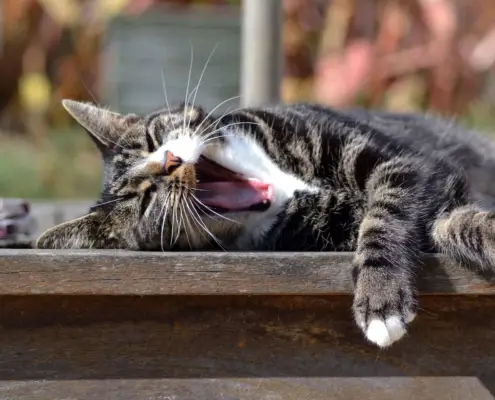
Cats have fascinated humans for centuries with their grace, agility, and mysterious nature. But have you ever wondered how these incredible creatures are classified and organized? In this article, we will delve into the world of cat taxonomy, exploring its history, the classification system, various cat species, evolutionary relationships, common misconceptions, and the importance of understanding this fascinating field. So, let’s embark on a journey to demystify cat taxonomy!
The History of Cat Taxonomy
The study of cat taxonomy dates back to ancient times when humans first began to observe and categorize the natural world. Ancient civilizations recognized the diversity among cats, but it wasn’t until the 18th century that formal classification systems were developed. Carl Linnaeus, a Swedish botanist, is credited with laying the foundation for modern taxonomy. He introduced the binomial nomenclature system, assigning each species a unique scientific name consisting of two parts – the genus and the species.
What is Cat Taxonomy?
Cat taxonomy is a branch of biological classification that focuses on categorizing and organizing different cat species based on their evolutionary relationships and shared characteristics. It involves studying the morphological, genetic, and behavioral traits of cats to determine their relationships and place them in appropriate taxonomic groups. This comprehensive approach enables researchers to better understand the evolutionary history and biodiversity of these remarkable animals.
The Classification System of Cat Taxonomy
The classification system used in cat taxonomy is hierarchical, with different levels of classification. Starting from the broadest level, cats belong to the kingdom Animalia, the phylum Chordata, and the class Mammalia. Moving down the hierarchy, they are classified into the order Carnivora, the family Felidae, and the genus Felis. Finally, each cat species is designated by a unique combination of genus and species names. For example, the domestic cat’s scientific name is Felis catus.
The Different Cat Species and Their Taxonomy
Cats encompass a wide range of species, each with its own unique characteristics. Some of the well-known cat species include the domestic cat (Felis catus), lion (Panthera leo), tiger (Panthera tigris), leopard (Panthera pardus), cheetah (Acinonyx jubatus), and jaguar (Panthera onca). Each species is classified based on its distinctive physical traits, behavior, and genetic makeup. Understanding the taxonomy of these species helps us appreciate their diversity and conservation needs.
Evolutionary Relationships in Cat Taxonomy
Cat taxonomy provides valuable insights into the evolutionary relationships between different cat species. Through careful analysis of fossils, DNA sequencing, and comparative anatomy, scientists have been able to trace the evolutionary history of cats. It is believed that all modern cats share a common ancestor that lived around 11 million years ago. This ancestor gave rise to various lineages, resulting in the diverse cat species we know today.
Common Misconceptions About Cat Taxonomy
There are several misconceptions surrounding cat taxonomy that need to be addressed. One common misconception is that domestic cats are a separate species from wild cats. In reality, domestic cats (Felis catus) are a subspecies of the wildcat. Another misconception is that big cats, such as lions and tigers, are a separate group from small cats. In fact, all cats, big and small, belong to the same family (Felidae) and share a common ancestry.
The Importance of Understanding Cat Taxonomy
Understanding cat taxonomy is not just a matter of academic interest; it has practical implications as well. By studying the evolutionary relationships and genetic diversity among cat species, researchers can gain insights into their conservation needs, breeding programs, and health management. Taxonomy helps identify endangered species, guide conservation efforts, and develop strategies to protect these magnificent creatures and their habitats. Moreover, understanding cat taxonomy enhances our appreciation of their unique adaptations and behaviors.
Cat Taxonomy in Scientific Research
Cat taxonomy plays a crucial role in scientific research, particularly in fields like evolutionary biology, genetics, and ecology. By accurately classifying and identifying cat species, scientists can conduct comparative studies to understand the genetic basis of certain traits or behaviors. They can also investigate the impact of environmental changes on different cat populations and assess their vulnerability to various threats. The knowledge gained from cat taxonomy contributes to our broader understanding of biodiversity and the interconnectedness of species.
Conclusion
In conclusion, cat taxonomy provides a systematic framework for classifying and understanding the diverse world of cats. It enables us to appreciate their evolutionary history, genetic relationships, and unique adaptations. By demystifying cat taxonomy, we gain a deeper understanding of these remarkable creatures and can take steps to conserve and protect them for future generations. So, the next time you encounter a cat, remember that its classification goes beyond its name – it represents a rich tapestry of biological knowledge and awe-inspiring beauty.
If you enjoyed my article, I would appreciate you sharing it with your network.

Sima Ndlebe
Sima writes for CatBuzz. He is interested in Cats, Health and Fitness, and Entrepreneurship.
Published: 13 November 2023



